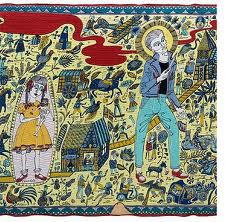William Morris Gallery reopens with Grayson Perry’s Walthamstow Tapestry

The William Morris Gallery in Walthamstow has had a major revamp and reopens fit for the 21st century. A few years ago, the gallery was dark and tired; lottery and other funding has reimagined this venue, and given it the flexibility and vision to put itself on the cultural map. New features include a newly planted Morris-inspired garden designed to embody his natural design material and give year-round interest.
Architects and exhibition designers Pringle Richards Sharratt have taken on board best practice from other updated galleries, and not overdone the family friendly interactive elements, but have integrated them sensitively amongst the treasures exhibited. For those who just like to look at the art without having to read endless captions and explanations, it is the Morris aesthetic, above all, which dominates and seduces. The captions are, however, informative and insightful into the man, his time, and his extraordinary work. Morris was a Victorian revolutionary, railing against the stuffiness of both living rooms and attitudes.
Original wallpaper sketches and prints, stained glass windows, furniture and paintings by Morris and his contemporaries are included alongside his other enterprises – the Kelmscott Press which reworked myths and legends in beautiful script, the workshop which shows how the objects were made, and a sumptuous recreation of the Morris shop where furnishings were sold – then, as now, offering a lifestyle.
Water House sits on the edge of Lloyd Park, sweeping elegance amidst the sprawlopolis which is Walthamstow, and was the childhood home of William Morris, the influential artist, writer and social reformer. More a one-man art movement, he was prolific and successful in many fields, and championed a preindustrial, less cluttered way of life. Although his medieval inspiration is undeniably romantic, Morris was deeply practical and believed that beauty should be part of the everyday, and not a luxury of the privileged few. The irony, of course, is that Morris came from considerable wealth, and could afford such principles. However, he was a man of deep conviction who devoted much of his life to socialist reform and tirelessly campaigned for better conditions for the masses.
“No man is good enough to be another’s master.”
Students, researchers and scholars of William Morris and his contemporaries now have a library and access to source archive material, available by appointment. Although there are other Morris houses which he actually designed and decorated, this grade II Georgian building will house the main source of reference publically available for all things Morris-related.
“I do not want art for a few any more than education for a few, or freedom for a few.”
The gallery now has a full programme of events, activities and curator’s talks highlighting the arts and crafts and pre-raphaelite movements. There is an artist-in-residence programme and a series of exhibitions by contemporary artists and craftspeople, the current inheritors of Morris’ ethos. The first of these brings a chance to see Grayson Perry’s Walthamstow Tapestry, a modern take on consumerism in his inimitable style. Perry’s studio is local, and somehow continues in Morris’s tradition of beautiful things having meaning.
The values espoused by Morris and the arts and crafts movement are still relevant – quality and integrity of production, fair working practices, and good taste.
William Morris: useful and beautiful.
Eleanor MacFarlane
Photos: Courtesy of William Morris Gallery
Grayson Perry’s Walthamstow Tapestry is at the William Morris Gallery until 23rd September 2012. For further information or to book visit the exhibition’s website here.

























Facebook
Twitter
Instagram
YouTube
RSS